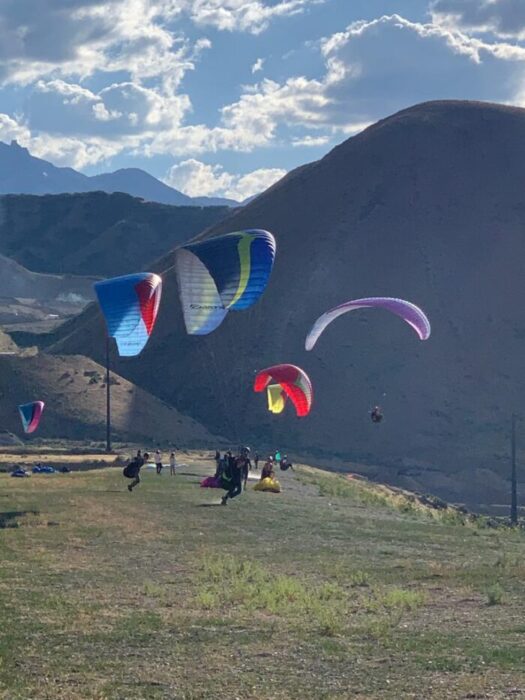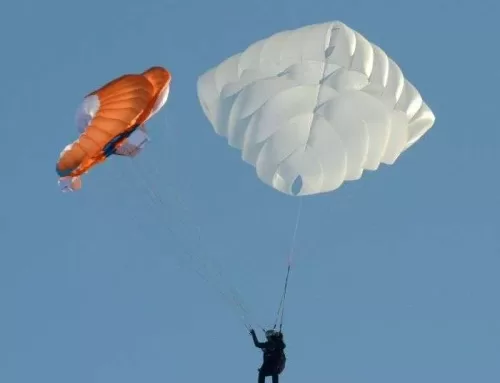ONE OF THE BEST WAYS TO IMPROVE YOUR FLYING
Most of the best pilots have very good ground handling skills honed by hours of continual practice while staying on the ground!
The equipment we use to ground handle always includes wearing a rated helmet, gloves to protect from line burns and a harness attached to your wing (attaching to your wing sounds obvious but there have been many injuries where people were only holding the risers in their hands, got lifted off the ground and fell to the ground). Use normal equipment, what you’d normally use for flying, that gives you good practice, gets you familiar with the feeling of your harness and your glider.
Some prefer to practice on a smaller wing like the BGD SEED, designed only for ground handling, its advantages are that you are less likely to get plucked into the air or dragged across the ground and can be kited in stronger winds.
A difficult task for all new pilots is learning to ground handle a paraglider. Like all things, with practice it becomes easier. Find an open flat field and only practice in light consistent winds. Avoiding areas where if you get dragged you could hit a fence, street, buildings or river. Stay away from areas where you’re downwind of obstacles that will churn the air and create turbulence and rotor which will make it difficult to keep the wing above you. As your skills improve then moving to a gentle slope can bring new challenges to the game!
Ground handling your paraglider is fun, you can challenge yourself with many variations of “kiting” your wing. I like to practice wing tip touches, killing the wing (deflating the wing to the ground) with the C risers and A risers, spins and more.
Practice Ideas for Ground Handling
- In the beginning, just focus on keeping it up in a reversed position. So do a reverse launch facing the wing, pull the wing up, and just work on keeping it up. Nothing fancy, just moving under the wing to center it. Whenever it falls over one side or the other, moving your feet, keeping the wing up.
- Try do small brake corrections, and big corrections with your feet. But then mix it up. Do it the other way around, just so you can learn what the inputs are doing. Use no foot input at all, just stay in one spot, try and do everything on the brakes, and see how that changes the feeling of the wing and its responses.
- Turn around and face forward, doing the same by feeling alone. So, you’re just looking at the ground, you’re looking ahead, and you’re feeling what the wing is doing, which way it’s pulling, responding to move underneath the wing if it’s pulling one way or the other. Trying to feel what brake you need to put input in just to correct the yaw on the wing and bring it back to center. You can spend quite a long time just walking around until you feel completely connected with your wing.
- Practice loading up the chest strap before running. This helps prevent the harness from sliding up your legs, and it also gives you much better connection with the wing than running upright. So, try and load the chest strap up and then increase to flying speed, covering the minimum distance.
- Work on slowly bringing the wing up, so controlling that speed that it’s coming up with a slow rise. You control the speed by your movement, so moving away from the wing or towards the wing to control that pullup speed taking the power out of the wing to bring it up as slowly as you can so it’s still coming up all the time and it’s not dropping back.
- Work on a slow descent, controlling the descent speed by using your A’s. This will give you some control, develop a feeling of the power in the wing, and also save your wing from being whacked down on the ground.
- Explore the stall point. Try and drop the wing back a bit either by walking towards it, or using a bit of brakes, or both, and try and establish exactly where the point is on the arc when your wing stalls.
- Every wing is different, it depends on the wind speed and the slope you’re standing on, but it’s very good to get an idea of when it’s about to stall, and just as it stalls, see if you can get it to re fly. So, work with that, stalling it, letting it re fly. You might need to grab the A’s to re-engage it, to energize it again, it depends on the wing. But play with that and experiment with more or less stall, so you really learn about that transition phase between the wing flying and the wing not flying.
- Do tip touches to develop fine control on the brakes. Sending the wing over to the side really slowly. Trying to keep your body position fixed, leaning away from the wing, so rotate your body slightly so you’ve got a nice balanced position, and then use the brake to just slowly fly the wing back up over head. On launch those who practice ground handling often have the best launches. In the air you’ll be more sensitive with the controls and more aware of the movements your wing is making.



